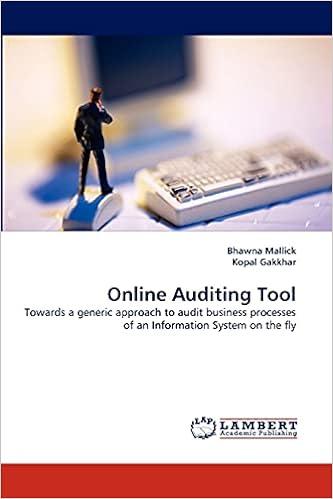Answered step by step
Verified Expert Solution
Question
1 Approved Answer
The following transactions occurred at several different businesses and are not related. INSTRUCTIONS Analyze each of the transactions. For each, decide what accounts are affected




The following transactions occurred at several different businesses and are not related. INSTRUCTIONS Analyze each of the transactions. For each, decide what accounts are affected and set up T accounts. Record the effects of the transaction in the T accounts. TRANSACTIONS 1. Serena Hamilton, an owner, made an additional investment of $42,000 in cash. 2. A firm purchased equipment for $20,000 in cash. 3. A firm sold some surplus office furniture for $3,400 in cash. 4. A firm purchased a computer for $3,700, to be paid in 60 days. 5. A firm purchased office equipment for $22,400 on credit. The amount is due in 60 days. 6. James Taylor, owner of Taylor Travel Agency, withdrew $12,000 of his original cash investment. 7. A firm bought a delivery truck for $38,500 on credit; payment is due in 90 days. 8. A firm issued a cheok for $7,200 to a supplier in partial payment of an open account balance. Analyze: List the transactions that directly affected an owner's equity account. Using T accounts to analyze transactions. [ Objective 3-2 Haden Fry decided to start a dental practice. The first five transactions for the business follow. For each transaction, (1) determine which two accounts are affected, (2) set up T accounts for the affected accounts, and (3) enter the debit and credit amounts in the T accounts. 1. Haden invested $90,000 cash in the business. 2. Paid $30,000 in cash for equipment. 3. Performed services for cash amounting to $9,000. 4. Paid $3,800 in cash for advertising expense. 5. Paid $3,000 in cash for supplies. Objective 3-3 Indicate whether each of the following accounts normally has a debit balance or a credit balance: 1. Cash 2. Blaine Brownell, Capital 3. Fee Income. 4. Accounts Payable 5. Supplies 6. Equipment 7. Accounts Receivable 8. Salaries Expense Identifying debits and credits. Objective 3-3 In each of the following sentences, fill in the blanks with the word debit or credit: 1. Revenue accounts normally have balances. These accounts increase on the side and decrease on the ? side. 2. Liability accounts normally have balances. These accounts increase on the side and decrease on the side. 3. Expense accounts normally have balances. These accounts increase on the side and decrease on the side. 4. Asset accounts normally have balances. These accounts increase on the side and decrease on the side. 5. The owner's capital account normally has a balance. This account increases on the side and decreases on the side
Step by Step Solution
There are 3 Steps involved in it
Step: 1

Get Instant Access to Expert-Tailored Solutions
See step-by-step solutions with expert insights and AI powered tools for academic success
Step: 2

Step: 3

Ace Your Homework with AI
Get the answers you need in no time with our AI-driven, step-by-step assistance
Get Started


